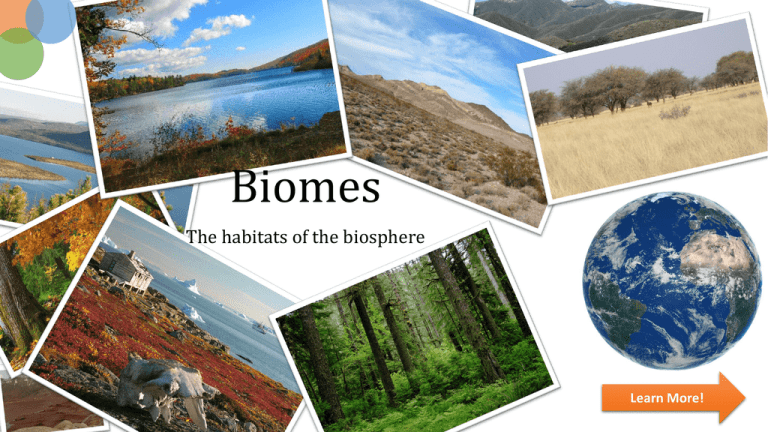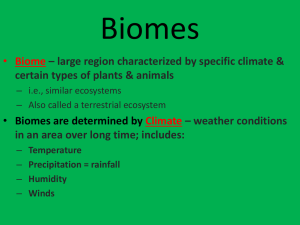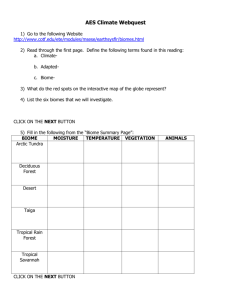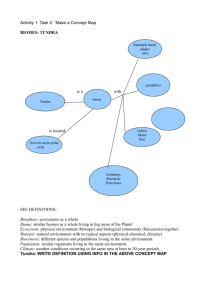Biomes of the Earth
advertisement

Biomes The habitats of the biosphere Learn More! What is a Biome? Biomes are regions of the biosphere (the earth) that are defined by geographic area and climate. Each biome has characteristic flora and fauna that result from these variables. There are two types of biomes: terrestrial and aquatic. Aquatic biomes are defined by bodies of water whereas terrestrial biomes are purely land based. Watch this introduction to biomes! Learn More! Why are Biomes Important? Biomes form the various habitats of the biosphere. We currently have only one biosphere—the earth. By learning about biomes, we are able to condense macro biodiversity into a more easily consumable package. After learning about biomes in general, we can begin to appreciate the impact that humans have had on them and therefore the entire biosphere. We can then begin to appreciate the uneven impact of human activity on each biome. Learn More! Why are Biomes Important? As we understand more about the way our biosphere works, we are able to utilize the principle of uniformitarianism. That is, all natural processes occur the same way throughout history. Then, we can ponder where our biosphere came from, and where it is going. Hot topics in the field of where our biosphere are going include rising sea levels and relentless climate change. Check out this interesting video about Earth in 1,000 years! You may wish to skim the video—it is approximately half an hour in duration. Learn More! Terrestrial Biomes of the Earth Wait! What’s a Biome? Polar Ice and Glaciers Polar ice is not a biome. On our map of terrestrial biomes, it is used to indicate areas of extensive glaciers. Glaciers are large formations of ice that cover land. Glaciers are not stationary—they move across the land in a process known as glacial drift. Glaciers are not considered biomes because they do not have a characteristic flora that results from the climate. Over time, the movement of glaciers across land creates a special sort of soil known as glacial till. The presence of till is an easy way to identify prehistoric ice ages. Tundra The word tundra is Russian for “treeless mountain.” The tundra is characterized by cold temperatures Few natural resources of interest and short growing seasons that to humans can be found in the inhibit tree growth. tundra. Therefore, tundra is often thought of as a kind of cold The primary vegetation in the wasteland. tundra is composed of dwarf shrubs, grasses, mosses, and Tundra is limited to northern lichens. Russia, northern Canada, Alaska, and Greenland. Taiga The taiga, also known as the boreal forest, is the largest terrestrial biome. Its expansive coniferous forests cover large swaths of inland Canada and Alaska. Furthermore, it covers most of Finland, Norway, and Sweden. The taiga is the coldest terrestrial biome after the tundra. It is defined by its long winter. Permanent ice caps are not unknown throughout the taiga. Large swaths of the taiga have been clear-cut for toilet paper and newsprint. This practice is very disruptive to soil of the taiga. Temperate Forest The temperate forest is characterized by a continuous canopy of broad-leafed trees. Temperate forests are often classified as deciduous or evergreen, depending upon the dominant tree species. The temperate forest covers the Eastern United States, including Georgia. The temperate forest has a high level of diversity, including many tree species such as oaks, beech, and maples. High climate variability has encouraged the development of specialized leaves, such as the pine needle. The temperate forest is often utilized for logging and small scale agriculture. Tropical Forest Tropical forests are defined by their warm temperatures and significant amount of rainfall. They are so named because they tend to occur between 30 degrees North and South—the Tropics of Cancer and Capricorn. The tropical forest is organized into different layers of canopy. Each layer has a different ecosystem. Tropical forests have boasted humans for millennia. Many groups of indigenous peoples still inhabit tropical forests. Over one half of the tropical forests in the biosphere have been destroyed by human activity. Temperate Grassland Temperate grasslands are arid regions underlain by highly fertile soils. The temperate grassland covers the Midwestern United States. Temperate grassland fauna is fairly low in diversity. Bison, rodents, and coyotes are notable. The temperate grassland is dominated by perennial grasses (hence the name). Sunflowers are not uncommon. Since the invention of the steel plow, the temperate grassland has been exploited as agricultural land to support the ever-increasing human population. Savanna The savanna is a transition grassland with trees spaced such that the canopy never closes. There are very clearly defined wet and dry seasons. Savanna is characteristic of central Africa and South America. The savanna is a very important area for biodiversity. As a transition area, it supports many grassland and desert species. Due to the extremely dry conditions, much of the flora is fire resistant. Use of the savanna as grazing land has led to the depletion of grasses and increase in erosion of the topsoil. Less grass for natural fires also results in the incursion of invasive woody plant species. Desert The desert is a highly arid biome with little precipitation. Only organisms that have developed adaptations for low water availability are successful in this biome. The desert is characteristic of much of Central Africa and the Australian Outback. The desert is generally inhospitable to humans. However, desert farming is possible with irrigation systems. The year-long constant sunlight offers excellent opportunities for sustainable solar energy power plants. Chaparral The chaparral is a droughttolerant shrubland. Its name comes from the Spanish word chaparro (scrub oak). The flora of the chaparral consists of shrub-like trees, buckwheat, lilacs, and sage. Infrequent wildfires are important for the maintenance of the ecosystem. Human development has often halted many productive wildfires The climate of the chaparral can in the chaparral. This results in a be thought of as “mediterranean.” buildup of fuel for future fires, It features hot, dry summers and which are often sparked by other mild, rainy winters. human activities, such as campfires. Mountains Mountainous areas are transition zones between multiple biomes. For example, in the United States, the temperate forest of the Pacific Northwest transitions to the temperate grassland of the Midwest when crossing the Rocky Mountains. Mountains themselves usually do not have soil that is able to support a characteristic flora. Furthermore, most mountains are high enough in altitude that solar radiation becomes a major concern for life.







